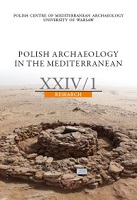FAUNAL REMAINS FROM THE FORTIFIED SETTLEMENT AROUND THE CHURCH AT BANGANARTI IN SUDAN
FAUNAL REMAINS FROM THE FORTIFIED SETTLEMENT AROUND THE CHURCH AT BANGANARTI IN SUDAN
Author(s): Marta OsypińskaSubject(s): Archaeology, Cultural history, Ancient World
Published by: Wydawnictwa Uniwersytetu Warszawskiego
Keywords: archaeozoology; Sudan; Makuria; African livestock; history of Nubia; economy; animals; meat consumption; animal breeding; African cattle; Christian kingdoms in Nubia
Summary/Abstract: The assemblage of faunal remains from Banganarti subjected to archaeozoological examination counted 4178 bones and fragments of bones. They represented contexts recorded within the fortified settlement around the church in Banganarti, attributed to two different chronological phases: 7th–10th century AD (Early Makuria) and 11th–12th century AD (Classic Makuria). Species identified among the 1066 osteological remains from the first phase included mammals, fishes and mollusks. Domestic ruminants dominated this group: sheep/goat (42.77%) and cattle (41.08%); pig was also frequently recorded (12.38%). Bones from the second phase (1513 identified remains) were identified most frequently as cattle (43.75%), sheep/goat (32.78%) and pig (19.69%). Trace remains of donkey, dromedary, dog and bush pig were observed. The analysis gave rise to the first ever characteristic of breeding and meat consumption models for a settlement in the Kingdom of Makuria, outside the capital located at Old Dongola. Beef and pork proved to have a growing importance in consumption patterns in Banganarti over the ages. A study of animal morphology allowed breeds to be established.
Journal: Polish Archaeology in the Mediterranean
- Issue Year: 1/2015
- Issue No: XXIV
- Page Range: 411-424
- Page Count: 14
- Language: English

